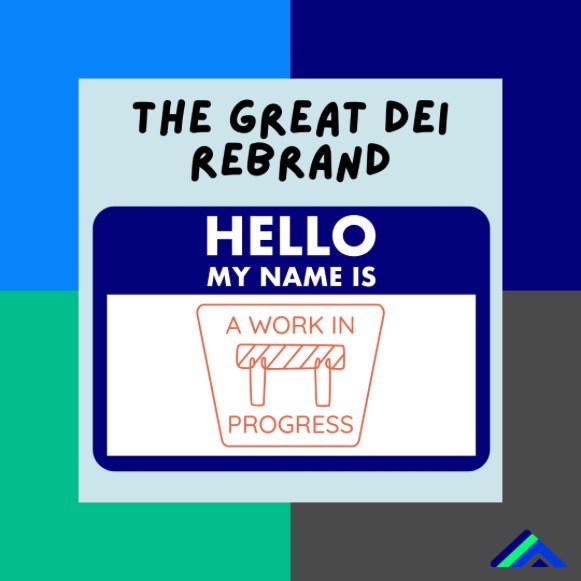Why Organizations Are Renaming Their Committees and Roles
|
|
In the evolving landscape, one thing has become clear: the language of diversity, equity, and inclusion (DEI) is shifting. Across industries, organizations are reconsidering how they frame their DEI efforts, with many rebranding committee names, adjusting leadership titles, or integrating equity-focused work under broader umbrellas like “culture,” “belonging,” or “people strategy.” But what’s really driving these changes? And does a name change truly signal a shift in commitment—or simply a shift in perception?
The Current Climate: A Strategic Pivot or a Step Back?
DEI efforts have faced increasing scrutiny, particularly in sectors where political and cultural debates have made these initiatives more complex to navigate. To align with the current federal administration directives, even more organizations are adjusting their language, carefully reassessing how they position their equity work to maintain compliance. Some are opting to soften or broaden the language to maintain engagement and avoid controversy, while others are genuinely rethinking their approach to embedding equity in a sustainable way.
For example, we’ve seen “Vice Chairs of DEI” become “Vice Chairs of Inclusion and Wellness” and DEI committees rebrand as “Equity & Belonging Councils” or “Access, Opportunity, & Inclusion Task Forces.” While these shifts may seem cosmetic, they often reflect deeper organizational strategies to protect and sustain their commitments to equity—sometimes more effectively under a new banner.
What’s in a Name?
For years, I have asserted that titles matter, particularly when it comes to DEI and health equity leadership. Language shapes perception and influences the level of authority and value given to a specific group or leader. Titles and committee names may be shifting, but what matters most is whether these changes reinforce or dilute the impact of equity-driven leadership.
If done well, renaming can provide long-term sustainability by embedding equity efforts into core organizational strategy and operations. However, when transparency and communication are lacking, these changes can create confusion, skepticism, and distrust. Without clear messaging, organizations risk signaling retreat rather than reinforcing commitments. |
|
Without clear messaging, organizations risk signaling retreat rather than reinforcement.
What’s At Stake?
Many leaders are concerned that these rebrands will dilute the original intent of this work. After all, there’s a fine line between rebranding to enhance engagement and rebranding to quietly deprioritize equity initiatives. At ODLC, we work with leaders across the healthcare industry who are asking an important question: How do we ensure that our work remains impactful, regardless of the terminology we use?
Here are some common leadership concerns:
⛔Perceived Dilution of Commitment – If changes are not clearly communicated, team members, learners, and stakeholders may view them as a step backward, raising concerns about whether equity work is being deprioritized.
⛔Loss of Institutional Foundations – Rebranding without a clear strategy can lead to disruption, where long-standing initiatives lose traction, subject matter expertise becomes outdated, and key personnel feel displaced or undervalued.
⛔Compliance and Legal Implications – As equity-related regulations evolve, shifting language without aligning it with a strong, measurable strategy can leave organizations vulnerable to compliance gaps and missed opportunities for funding or accreditation.
There’s a fine line between rebranding to enhance engagement and rebranding to quietly deprioritize equity.
Moving Forward: Strategy Over Semantics
As organizations and committees rethink their DEI structures and language, the key is to focus on substance over semantics. A change in title doesn’t inherently mean a loss of focus. If anything, it can be an opportunity to refine strategy, integrate equity efforts into core business objectives, and ensure leadership buy-in.
Here’s how to turn rebranding into reinforcement: |
|
| ✅Clarify the Why: If rebranding a DEI initiative, committee, or role, ensure there is a clearly communicated rationale that reinforces the commitment to equity.
✅Focus on Integration: Embedding equity work into organizational strategy—ratherthan keeping it siloed—can strengthen its longevity, regardless of the title it falls under. The ODLC Strategic Diversity Leadership Certificate program is an excellent learning experience to develop effective approaches to achieving such system-wide integration.
✅Measure and Communicate Impact: If the work is producing tangible results,language shifts will be less of a concern. Data-driven storytelling is essential. Leverage the ODLC Equity Leadership Index (ELI) Assessment to measure your organization’s current state and identify opportunities for progress that can be tracked over time.
✅Leverage Community & Networks: Engaging with peer organizations, industryleaders, and professional communities like ODLC can provide valuable insights into sustaining and evolving this work effectively. Secure, private platforms, such asODLC Nation, are productive resource areas to share best practices and connect with leaders who are facing similar complexities. |
|
| The landscape may be shifting, but the mission remains the same. The challenge ahead is not just about what we call this work—it’s about ensuring that whatever we call it, it remains deeply embedded in our organizations, our leadership structures, and, most importantly, our actions.
I reposted some recent articles below that provide additional perspectives on reframing and rebranding. Please let us know how we can continue to support you and your teams, including providing guidance on your strategic pivot.
Holding the line,
Dr. Erica Taylor |
|


